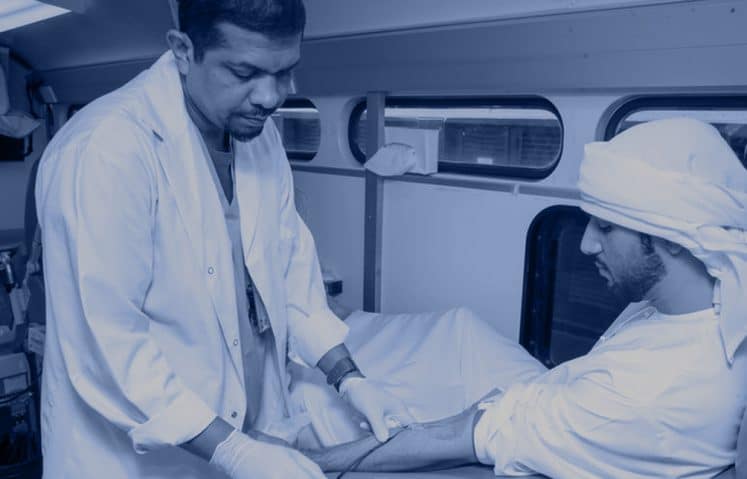Monday, 2024-04-08
On World Blood Donor Day, a heartfelt plea to help save lives BY DR. TAREK FATHEY

The coronavirus pandemic has shed a remarkably strong spotlight on the practice of health care, posing questions on its impact, efficiency and future. Not only has the global healthcare industry undergone years of change in a matter of months, but the pandemic serves as an opportunity to identify what’s working and what isn’t.
According to a report by the American Hospital Association, healthcare leaders must prioritise three foundational elements of health as they grow and expand their systems, particularly now as we step into the next phase of managing the pandemic.
Implementing information-powered clinical decision-making, building a primary care-led medical workforce, and reinforcing patient engagement and community integration are all key elements that will contribute to a successful healthcare system.
The first two are essential building blocks that we, as the leaders of the UAE’s largest healthcare network, concentrate strongly on to ensure the delivery of world-class healthcare treatments for the benefit of the population’s overall health and well-being. But the third one is what I would like to focus on as the world observes World Blood Donor Day.
The aspect of patient engagement and community integration is two-fold. First, the extent to which healthcare providers communicate with the people in their environment, sharing tips and advice on preventative health, and raising awareness on the most prominent health conditions and their associated signs and symptoms so members of the community can better manage their health journeys.
Second, and more importantly, is the onus on the patient and the community to become part of the global healthcare journey.
Patients have a significant role to play – not only by taking good care of their own individual health and well-being and that of their families, friends and loved ones, but also by lending a helping hand.
Blood, its components and their transfusion are a critical aspect of care and public health. Blood transfusions, quite literally, save lives. Yet, due to the ever-changing healthcare landscape and unforeseen circumstances, it is practically impossible for blood banks around the world to hold sufficient blood at all times, without the help of the community.
Unfortunately, the reality is that worldwide, many patients requiring transfusion do not have timely access to safe blood. While the reasons for insufficient stock of safe blood will differ from country to country and system to system, the underlying cause is lack of donors.
There are several reasons why members of the community do not donate – fear of needles, not enough time, never being asked, donated once or twice and think that’s enough, worry of feeling weak afterwards, and the list goes on.
None of the reasons people have for not donating blood are justifiable when we see millions of people across the globe desperately in need, whether to treat ongoing conditions that require regular blood transfusions like anemia, thalassemia or cancer, or in the case of an emergency or crisis situation.
Not to mention, the benefit to the donor – blood donation activates the bone marrow cells (where the blood is produced) which increases their effectiveness to produce new blood cells.
It is ironic that the simplest of fluids, which is the easiest to donate, can make the difference between life and death for many – and yet is under-resourced.
Thankfully, in the years before the pandemic, there was an upsurge in voluntary donors. The World Health Organisation reported an increase of 7.8 million blood donations from voluntary unpaid donors between the years 2013 and 2018. During that time span, 79 countries collected over 90 per cent of their blood supply from voluntary unpaid blood donors, with a smaller number of countries, 56, collecting more than 50 per cent of their blood supply from family members or paid donors.
We know that as long as humanity exists, there will always be a need for blood donations. Blood banks and health systems can never have too many units of blood – as the fundamental lifeline that keeps us breathing and alive, blood and its components will always be in demand.
In response to those afraid of contracting Covid-19 when visiting donation centres, blood banks, like hospitals, have implemented vigorous safety and precautionary measures to protect donors. For instance, Abu Dhabi Blood Bank Services (ADBBS), provider of blood transfusion services for the Emirate of Abu Dhabi, can only be visited by limited donors at a time to ensure physical distancing, has a sanitisation tent for donors to walk through, has facilities for donors to thoroughly wash their hands before and after they give blood, and asks a comprehensive set of questions before collecting donations.
ADBBS’s preventative measures have paid off, with approximately 55,000 individuals donating blood during the year 2020, allowing the blood bank to collect 60,000 units of blood that made an important impact on the lives of thousands of patients receiving critical and emergency care.
The healthcare system is built for our needs, but it is also ours to help. I wholeheartedly encourage all of us who can donate, to find out where the nearest donation centres are and to give blood to transform the lives of countless patients.
Published on June 14 2021, in “The National